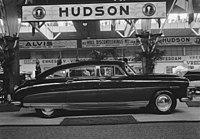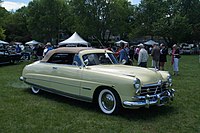This article needs additional citations for
verification. (March 2021) |
| Hudson Commodore | |
|---|---|
 1947 Hudson Commodore Convertible Brougham | |
| Overview | |
| Manufacturer | Hudson Motor Car Company |
| Production | 1941–1942 1946–1952 |
| Assembly | Detroit, Michigan, United States |
| Body and chassis | |
| Class | Full-size |
| Layout | FR layout |
| Chronology | |
| Predecessor | Hudson Greater Eight |
The Hudson Commodore is an automobile that was produced by the Hudson Motor Car Company of Detroit, Michigan between 1941 and 1952. During its time in production, the Commodore was the largest and most luxurious Hudson model.
First generation
| First generation | |
|---|---|
 1941 Hudson Commodore 8 Convertible | |
| Overview | |
| Production | 1941–1942 |
| Body and chassis | |
| Body style | 2-door
coupe 4-door sedan 2-door convertible |
| Powertrain | |
| Engine | 202 cu in (3.3 L)
I6 254.4 cu in (4.2 L) I8 |
| Dimensions | |
| Wheelbase | 121 in (3,073 mm)
[1] Custom sedan: 128 in (3,251 mm) |
1941
The Commodore Series 12 and Series 14 were the junior models to the Commodore Custom Series 15 and Series 17. The junior models debuted in Hudson's 1941 model line. Commodore Series 12 featured a I6 engine and the Series 14 models came with a I8, with all built on a 121-inch (3,073 mm) wheelbase, while Commodore Customs utilized on the 121 in (3,073 mm) wheelbase for Series 15 coupes and a 128 in (3,251 mm) version for Series 17 sedans.
The Commodore was powered by Hudson's 202 cu in (3.3 L) I6 producing 102 bhp (76 kW), or by Hudson's 254.4 cu in (4.2 L) I8 that produced 128 bhp (95 kW). Prices listed for the Series 12 coupe started at US$1,028 ($21,295 in 2023 dollars [2]) to the top level Custom Series 17 Sedan at US$1,537 ($31,839 in 2023 dollars [2]). [3]
The Commodore series was Hudson's largest model range in its debut year, consisting of sedans, coupes, and convertibles. Hudson used a forward hinged hood that opened from the rear by the windshield with the front end of the hood sliding downward over the grille. Elements of the interior and exterior were styled by Betty Thatcher, "the first woman designer to be employed by a car manufacturer". [4]
1942
For the 1942 model year, the cars received a facelift. This included concealed running boards, modestly enlarged front grilles, and external trim arrangements. Hudson offered an optional "Drive-Master" vacuum-assisted clutch with a servo-operated transmission with three modes: "automatic" shifting and clutching, automated clutching only, or fully manual. [5]
The firm promoted its economy over luxury during the shortened model year that ended in January 1942, as U.S. war production accelerated.
Second generation
| Second generation | |
|---|---|
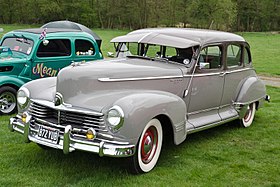 1947 Hudson Commodore Super Six four-door sedan | |
| Overview | |
| Production | 1946–1947 |
| Body and chassis | |
| Body style | 2-door
coupe 4-door sedan 2-door convertible 2-door pickup |
1946
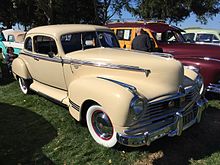
Hudson began postwar automobile production on August 30, 1945. Body styles were trimmed to Sedan, Club Coupe, and Convertible. The designs were based on the 1942 models. [6] There were minor cosmetic changes from the pre-war versions with one exception, the car's grille now had a concave center section.
Hudson automobiles were more fully equipped than competitive makes, and all Hudson models received door armrests, twin air-horns, ashtrays, windshield wipers, stop lights, locking glove box, sealed beam headlights, and deep pile carpeting. Commodore and Commodore Customs added foam rubber seat cushions (Hudson was the first automaker to introduce foam seat cushions), door-step courtesy lights, rear center armrest (sedans), and gold etched lettering on the dashboard panel.
1947
The priority was building cars following the war rather than introducing annual design changes for 1947 since Hudson was in the process of developing a completely new model. Production of the 1947 Hudson Commodore Eight increased to 12,593 from the previous year's 8,193. [6]
Third generation
| Third generation | |
|---|---|
 1952 Hudson Commodore 8 two-door hardtop | |
| Overview | |
| Production | 1948–1952 |
| Body and chassis | |
| Body style | 2-door
coupe 4-door sedan 2-door convertible |
1948

Hudson developed a new and radical car design. Production of the 1948 Hudsons began on 12 October 1947. [7] Introduced on 7 December 1947, the Hudson Commodore was one of the first new-design postwar cars made. [8] The 1948 model year inaugurated Hudson's trademarked "Monobuilt" construction or "step-down" automobile. The new cars were designed by Frank Spring and in part by Betty Thatcher, the first female designer to be employed by a car manufacturer. The marketing tagline for the innovative Hudsons was "Now You're Face to Face with Tomorrow." [7]
The cars had a light and strong semi-unit body with a perimeter frame. Because of the encircling frame, passengers stepped down into the vehicles. Hudson's step-down design made the body lower than contemporary cars. It offered passengers the protection of being surrounded by the car's chassis with a lower center of gravity. In addition to the safety of being surrounded by the car's chassis, the step-down also allowed Hudson to achieve weight savings through the unibody construction, making for a well-performing automobile. The "monobuilt" or "step-down design also required less steel for its production. [9]
The cars featured slab-sided bodies with fully integrated fenders. The Brougham and sedans were of a fastback design, while convertibles and coupes were notchbacks. A character line ran from the front to back further lowering the car even more visually, so "the new Hudson looked like a dream car straight from the auto show." [10]
In 1948, Commodores came in one series and were available in either I6 or optional I8 engines. Interiors were upholstered in broadcloth on sedans, and leather on convertibles. Again, Hudson continued to provide numerous standard features that other manufacturers classified as upcharge options. Not only were the 1948 models "truly significant new designs of the early postwar years. The “Step-Down” Hudson was low and sleek, which many consumers really enjoyed." [7] Total Commodore production was 62,474 of which 35,315 were I8 units.
Sir Vival
In response to the increasing number of deaths on highways in the United States after World War II, an innovative concept car was designed and built for safety rather than for style or speed. [11] Using two 1948 Hudsons, Walter Jerome, built a hinged two-section car to minimize impact of collisions. [12] Among its many features are a centrally-positioned, raised 36 in (91 cm) turret-shaped driver compartment providing panoramic visibility, as well as safety equipment that would later become standard on production vehicles such as rubber bumpers, seat belts, and side marker lights. [13] Jerome had purchased the two donor Hudsons from Bellingham Motors, a Hudson dealership in Massachusetts, and was planning to build up to a dozen Sir Vivals per year, but only the prototype was completed and in early-1970s, it went back to Bellingham Motors for storage. [13] [14] With the closing of Bellingham Motors, in 2022 it was sold to Lane Motor Museum which plans to restore it. [15] [16] [17]
1949

For the 1949 model year, the Commodore line was enlarged to include more luxurious Custom models. As a marketing promotion, Hudson had plastic specialists use scaled-down blueprints to develop transparent models of the Commodore Eight sedan to demonstrate and promote the design and construction of the cars. [18]
1950

The most noticeable change to the 1950 model year was the restyled grille featuring a design that superimposed Hudson's signature triangle logo on four horizontal bars. This would become the "Hudson look." The 1950 models included a new split back window and redesigned interiors. A new Custom Commodore convertible model debuted in mid-April 1950.
1951
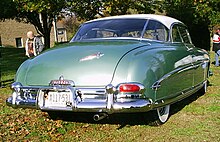
In 1951, Hudson introduced a new I6 engine and offered General Motors' Hydra-Matic as an optional transmission. The grille was redesigned from a rather rectangular shape to an oval shape, a design that would carry through to 1953. The grille would be redesigned again in 1954, the last year for the famous aerodynamic Hudson body style which was used from 1948 until 1954.
1952
In its final year in 1952, the Commodore was split into the Six Series and Eight Series. The exterior received another trim change, but by the end of 1953, the Step-Down styling was beginning to look outdated. Hudson lacked the resources to keep adding new and exciting changes to keep up with the competition from the other automakers, whose annual redesigns added tailfins and more chrome trim that consumers wanted. [7] Instead of redesigning the aging "set-down" models, company President A. E. Barit pushed ahead with the firm's plan for the Jet compact.
Discontinuation
Beginning in 1953, Hudson would field only the Hudson Hornet and Hudson Wasp line, as well as introduce the entirely new Hudson Jet compact car line.
Following Hudson's merger with Nash to form American Motors Corporation (AMC) in 1954, Hudson's automobile production was switched to AMC's facility in Kenosha, Wisconsin. Following slow sales of the 1955 model year, AMC turned Hudson styling to Richard Arbib, who created a unique look for the Hudson line based on what he termed "V-Line" styling. The new design did not attract customers to Hudson, and production fell even further.
1957 show car
In its final year, the Hudson brand was pared down to a single model, the Hudson Hornet, available in two trim levels, the top-level Custom and the Super. However, during the show car season, AMC prepared a one-off 1957 Hudson Commodore show car identical to the production Hornet, featuring gold exterior trim and unique upholstery.
Station wagon
In 1946, Hudson hired an experienced Army illustrator for instruction manuals and training materials. [19] Don Butler assisted with the final design drawings for the upcoming 1948 Hudsons. However, he also sketched unofficial proposals for Hudson that included a station wagon, a pickup, and a town car. [19] Butler's illustrations were an inspiration to build a Commodore station wagon. [19] A 1948 Hudson Commodore Eight four-door sedan served a donor with another car's roof added for the station wagon's rear section. [19] The woodie was hand-made of ash framing with mahogany veneer panels. [19] The car is a modern realization of an unbuilt postwar design. [20]
Notable owner
Actor Steve McQueen owned four Hudsons that he drove around Los Angeles. [21] His 1950 Hudson Commodore Six Brougham was the only convertible. [22] McQueen upgraded the standard I6 with a 308 cu in (5.0 L) Twin-H version from a Hudson Hornet. [23] [24]
-
3rd gen Commodore sedan at 1948 Amsterdam AutoRAI
-
1949 Hudson Commodore sedan interior
-
1950 Hudson Custom Commodore Convertible Brougham
-
1951 Hudson Commodore Custom Series Four-Door Sedan, rear
References
- Inline
- ^ "1942 Hudson brochure". oldcarbrochures.com. p. 5. Retrieved 18 April 2022.
- ^ a b 1634–1699: McCusker, J. J. (1997). How Much Is That in Real Money? A Historical Price Index for Use as a Deflator of Money Values in the Economy of the United States: Addenda et Corrigenda (PDF). American Antiquarian Society. 1700–1799: McCusker, J. J. (1992). How Much Is That in Real Money? A Historical Price Index for Use as a Deflator of Money Values in the Economy of the United States (PDF). American Antiquarian Society. 1800–present: Federal Reserve Bank of Minneapolis. "Consumer Price Index (estimate) 1800–". Retrieved February 29, 2024.
- ^ Kimes, Beverly (1996). standard catalog of American Cars 1805–1942. Krause publications. pp. 723–748. ISBN 978-0-87341-478-4.
- ^ "Collection in Action - H". Franschhoek Motor Museum, South Africa. 26 August 2015. Retrieved 18 April 2022.
- ^ "1942 Hudson". How Stuff Works. 16 September 2007. Archived from the original on 12 August 2020. Retrieved 18 April 2022.
- ^ a b "1946-1947 Hudson Commodore Eight". How Stuff Works. 20 July 2007. Archived from the original on 20 September 2020. Retrieved 18 April 2022.
- ^ a b c d Tate, Robert (7 December 2022). "The 1948 Hudsons Offered "Step-Down" Styling". motorcities.org. Retrieved 12 March 2024.
- ^ Neely, William; Lamm, John (1975). Cars to remember: thirty-seven great automobiles in retrospect. Regnery. p. 71. ISBN 978-0-8092-8241-8.
- ^ "1948 Hudson Sedan "Commodore"". audrainautomuseum.org. Retrieved 12 March 2024.
- ^ Flory, J. Kelly (2008). American Cars, 1946-1959: Every Model, Year by Year. McFarland. p. 153. ISBN 978-0-7864-3229-5.
- ^ Marquis, Erin (8 June 2022). "The Split-in-Two Hudson 'Sir Vival' Was Designed to Be Safe on Dangerous 1950s Roads". Jalopnik. Retrieved 7 August 2022.
- ^ Kozak, Graham (28 October 2013). "Meet Sir Vival, the safety car from a future that wasn't". Autoweek. Retrieved 7 August 2022.
- ^ a b Peek, Jeff (22 March 2022). "This center-hinged car was all about Sir Vival in 1958". Hagerty. Retrieved 7 August 2022.
- ^ "1958 Sir Vival". Bellingham Auto Sales. Retrieved 7 August 2022.
- ^ Strohl, Daniel (June 7, 2022). "Lane Motor Museum acquires Sir Vival, the two-piece safety Hudson". Hemmings. Retrieved 24 November 2022.
- ^ Bennett, Rex (July 21, 2022). "The Survival Of 'Sir Vival,' The Strangest Safety Car Concept Ever, Now Rests in the Hands of the World's Quirkiest Car Museum". theautopian.com. Retrieved 24 November 2022.
- ^ "Sir Vival- 1958". Lane Motor Museum. Retrieved 24 November 2022.
- ^ "Model Cars Built on Production Line". Popular Science. Vol. 154, no. 1. January 1949. p. 192. Retrieved 18 April 2022 – via Google Books.
- ^ a b c d e "1948 Hudson Commodore Custom Station Wagon". rmsothebys.com. 28 July 2012. Retrieved 12 March 2024.
- ^ Kozak, Graham (26 July 2012). "History crosses the auction block at St. John's". Autoweek. Retrieved 12 March 2024.
- ^ "Steve McQueen's 1950 Hudson Custom Commodore Six Brougham Convertible". schmitt.com. Retrieved 12 March 2024.
- ^ Golfen, Bob (7 December 2018). "Steve McQueen-owned Hudson Commodore Six convertible". journal.classiccars.com. Retrieved 12 March 2024.
- ^ Evans, Sean (10 April 2019). "Here's Why Steve McQueen's 1950 Hudson Commodore Is an Early Sleeper". Robb Report. Retrieved 12 March 2024.
- ^ "Ex-Steve McQueen 1950 Hudson Custom Commodore Six Convertible". Bonhams Cars. 12 August 2015. Retrieved 12 March 2024.
- General
- Gunnell, John, ed. (1987). The Standard Catalog of American Cars 1946-1975. Krause Publications. ISBN 978-0-87341-096-0.
- Conde, John A. (1987). The American Motors Family Album. American Motors Corporation. OCLC 3185581.
